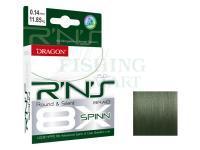Dragon HM X8 P.E. Braid

Dragon Braided lines R’N’S Spinn Invisible Round & Silent Braid

Dragon R’N’S Spinn Round & Silent Braid

Dragon Braided lines Silk TOUCH 8X Neon

Dragon Braided lines Silk TOUCH 8X Clear

Dragon Braided lines Invisible Vanish Red

Dragon Invisible Clear Braids

Dragon Fishmaker v2 Braided lines

Casting and spinning braids – Fishing shop
Fishing braid is an invention as old as fishing. This type of line is made of several braided fibers. Initially, these were fully natural fibers, such as linen or cotton. Over time, natural materials gave way to more technologically advanced ones. We are talking about high-modulus polyethylene (Spectra, Dyneema) or Dacron. The popularization of these has caused a real revolution in the fishing line market.
Currently, spinning and casting braids are used for almost all types of spinning - from the ultra-light version to the real big game - and many anglers cannot imagine fishing without braid.
Spinning braid - characteristics:
The most significant difference in use of this type of line is its linear and knot strength, which are unattainable for traditional nylon fishing lines. Suffice it to say that by using braid as the main line, we can afford to buy a product that is even three times thinner than a dedicated fishing line! What will it give us? First of all, it will make it easier to make long casts and improve contact with the bait.
Another very significant difference from mono lines is the lack of extensibility (which can be even over 30% for a line!). This feature allows you to feel both the bite and the work of the bait, hook the fish almost instantly, and the haul itself is a synonym for the phrase "contact with the fish".
Thanks to the lack of stretchability, spinning braids are a great choice for technically difficult fishing grounds, rich in vegetation and snags, forcing us to haul with force.
Interestingly, high strength and lack of stretchability do not necessarily have to indicate the stiffness of the braid. Modern manufacturers offer both stiff lines (often coated) and extremely soft ones. The case of roughness is similar - spinning braid is available in variants with different numbers of braids, from 4 to even 13. And in this way, a product made of four braids will be the noisiest, but also the most resistant to abrasion. A 12-strand line will give us a cross-section that is closest to round, often smooth, but its resistance to mechanical damage will be slightly lower.
Fishing braid
Spinning fishing braid comes in a variety of colors, from discreet, barely visible greens, through poisonous fluo colors, even multi-colored, rainbow, thanks to which observing bites is even easier, regardless of the weather.
It is worth knowing that the braid is not perfectly round in cross-section, which is why it arranges itself much worse on the spool than traditional line, and in addition, some models can absorb water and swell. Therefore, when choosing a spinning braid for your reel, we advise you not to be guided by the spool capacity given by the manufacturer, because in the vast majority of cases, this capacity applies to the line.
We recommend purchasing extremely sharp braid scissors that will not tear the braid and will work much better than traditional line cutters.
Recommended spinning braids
Our online fishing store offers the best spinning braids from renowned brands: Japanese YGK, Daiwa, Shimano and many other world-renowned brands.
The best spinning braid - which models to choose?
Choosing the best spinning braid is a key element of effective predator fishing. A properly selected braid ensures long casts, high abrasion resistance and excellent feel of the bait, which translates into better results on the water.What should the best spinning braid stand out with?
Durability and abrasion resistance - the solid construction of the braid allows fishing in difficult conditions, e.g. near stones, branches or underwater vegetation.Smoothness and slipperiness - high-quality coating reduces friction in the guides, which allows precise and long casts.Lack of stretchability - minimal elasticity allows for immediate reaction to bites and effective hooking of the fish.
The right number of braids - 4-braids are more resistant to abrasion, while 8-braids are smoother and quieter.
We invite you to check out our new fishing products for 2025 – Fishing Store








